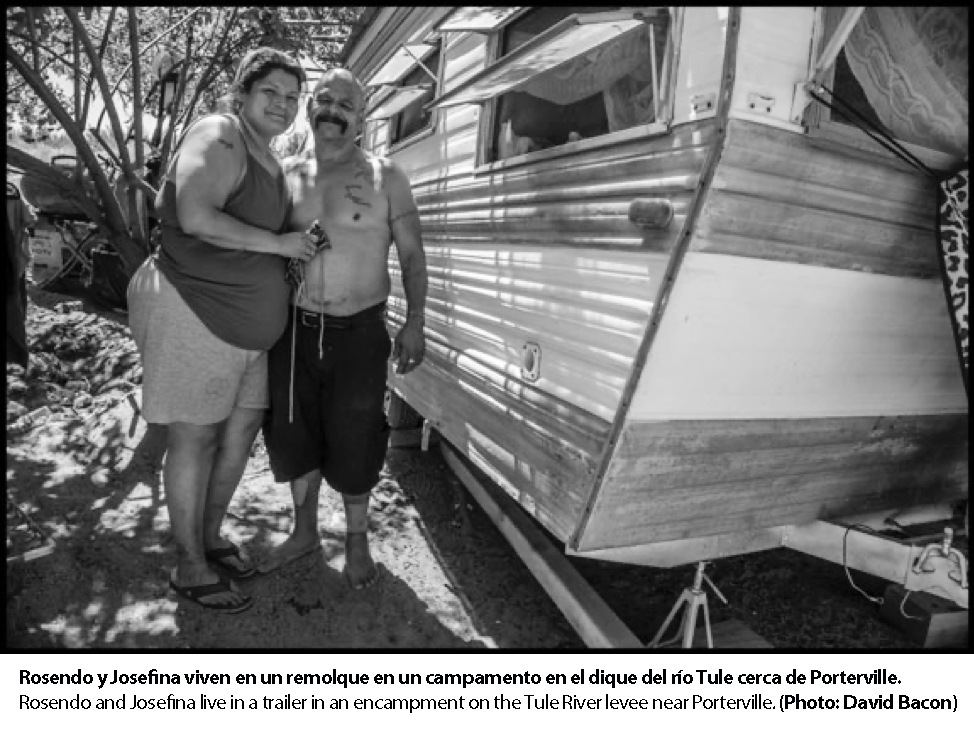by David Bacon
It was after midnight on Jan. 21 when Tulare County sheriffs walked into the encampment of unhoused people on the levee of the Tule River. “They parked on the highway,” remembers Rosendo “Chendo” Hernández, who shares a small trailer parked under a tree with his partner Josefina. “I heard them walking around in front, and then they called out to me to open my door. They said we were trespassing on private property and we had to leave.”
Sheriffs made him sign a notice, Hernández says, giving him a week to remove his possessions and find another place to live. Deputies then went to other levee residents who have set up shacks or impromptu shelters along the river. Mari Pérez, co-director of the Larry Itliong Resource Center in nearby Poplar, estimates that includes about 150 people.
“They said they’d arrest us if we didn’t sign,” Hernández recalls, and one officer, he charges, drew his gun.
“People are on edge, especially because of what happened on the St. John’s River.”
The sheriff’s warning to the Tule River residents came 10 days after police in neighboring Visalia, Tulare County’s largest city, evicted another group of people on the St. John’s River levee. Residents there were forced to take what possessions they could carry, while heavy construction equipment piled up what was left. A fire later broke out in which those possessions were incinerated.
Tulare County is not unique. Similar situations face unhoused people across the state. Here they are unfolding along rivers in the heart of the San Joaquin Valley, the country’s richest and most productive agricultural region. That wealth, however, does not produce housing for the valley’s impoverished residents, who instead face the use of law enforcement to remove them and render them invisible.
The use of police to get rid of the encampments of people living outdoors is hardly new, whether in the San Joaquin Valley or the rest of California. In 2009 a sweep by Visalia police of St. John’s River camps was witnessed by Bill Simon, then chair of the Fresno chapter of the American Civil Liberties Union. Afterwards, “The river was as empty as the dreams of the homeless who were being evicted,” he observed. “Some people [had] lived there for as long as seven to 14 years.”
Fresno, the valley’s biggest city, not only has the largest number of residents living on the street, but a long history of efforts to make them leave. The city passed a “ban on camping” on the streets in August 2017. In 2018 police had 9,000 “contacts” with people sleeping on sidewalks, yet their numbers continued to swell.
Jerry Dyer, former Fresno chief of police, was elected mayor last year, and he announced a new initiative on Jan. 22, “Project Offramp,” to force homeless people to leave camps set up on the property of Caltrans. “Even though it’s not our jurisdiction,” Dyer admitted, he will send police and city workers to tell the people sleeping near freeways to leave. “We can’t get used to homeless people living in our neighborhoods… It’s time we reclaim our neighborhoods and reclaim our freeways,” Mayor Dyer earlier told the local Fox affiliate.
The Offramp project will supposedly find housing for the 250 people which Dyer estimates live near freeways. But they are only some of the 2,386 people living out of doors in Fresno city and county in 2020, an increase of 598 just from the previous year.
Nevertheless, in 2019 the U.S. Supreme Court backed a ruling by the Ninth Circuit Court of Appeals holding that “people experiencing homelessness cannot be criminally punished for sleeping outside on public property if there are no available alterna
tives,” according to the National Low Income Housing Coalition. NLIHC president and CEO Diane Yentel explained, “Cities must stop attempting to criminalize and hide their communities’ homeless people and instead work toward providing real solutions, starting with the only thing that truly ends homelessness: access to safe, affordable, accessible homes.”
(Due to lack of space, this article was cut. You can see the full version at http:// elreporterosf.com/sin-alojamiento-arrojado-del-dique/)



